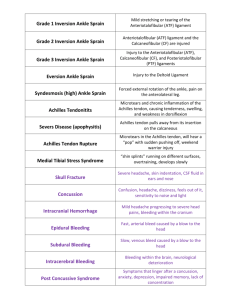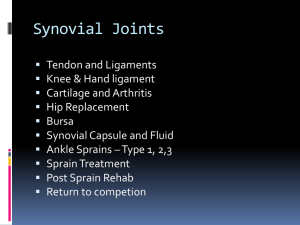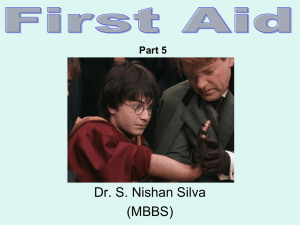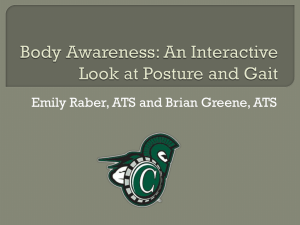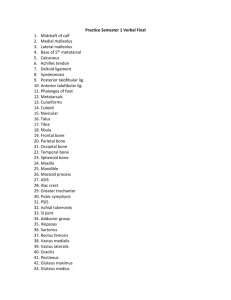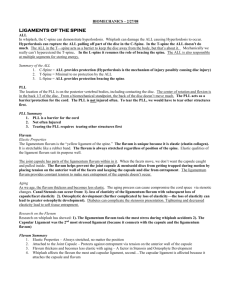Therapy Exam Question Archive
advertisement
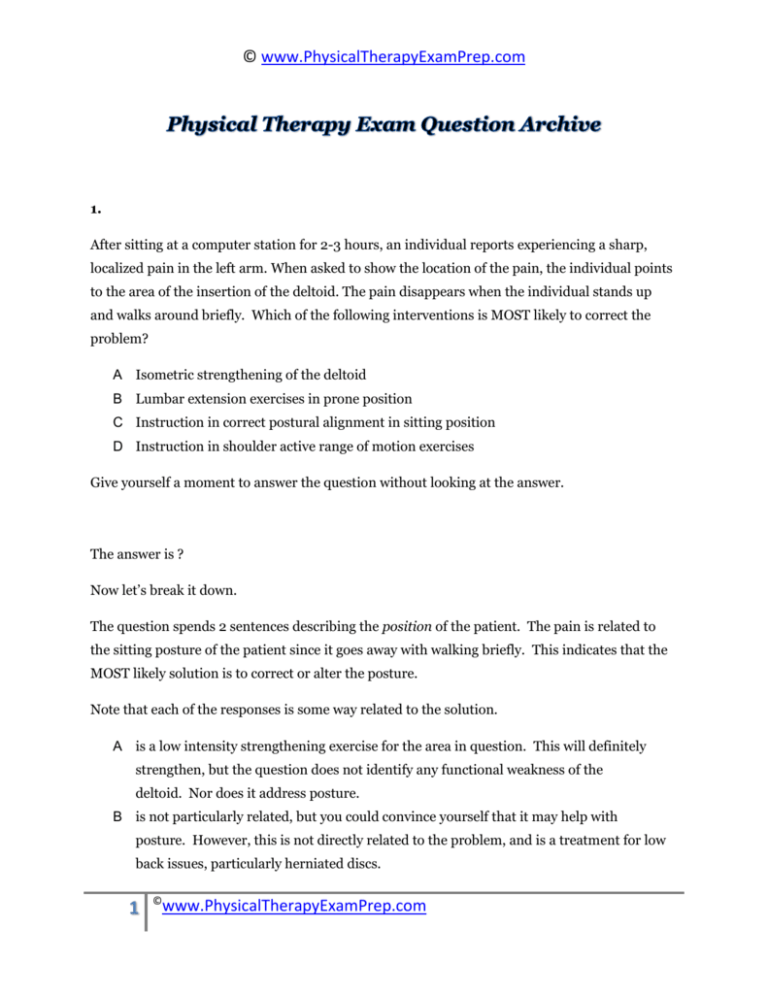
© www.PhysicalTherapyExamPrep.com 1. After sitting at a computer station for 2-3 hours, an individual reports experiencing a sharp, localized pain in the left arm. When asked to show the location of the pain, the individual points to the area of the insertion of the deltoid. The pain disappears when the individual stands up and walks around briefly. Which of the following interventions is MOST likely to correct the problem? A Isometric strengthening of the deltoid B Lumbar extension exercises in prone position C Instruction in correct postural alignment in sitting position D Instruction in shoulder active range of motion exercises Give yourself a moment to answer the question without looking at the answer. The answer is ? Now let’s break it down. The question spends 2 sentences describing the position of the patient. The pain is related to the sitting posture of the patient since it goes away with walking briefly. This indicates that the MOST likely solution is to correct or alter the posture. Note that each of the responses is some way related to the solution. A is a low intensity strengthening exercise for the area in question. This will definitely strengthen, but the question does not identify any functional weakness of the deltoid. Nor does it address posture. B is not particularly related, but you could convince yourself that it may help with posture. However, this is not directly related to the problem, and is a treatment for low back issues, particularly herniated discs. 1 © www.PhysicalTherapyExamPrep.com © www.PhysicalTherapyExamPrep.com C is the most correct answer. It briefly describes instructing the patient on correct postural alignment and may mimic the effect that standing and walking around has on the pain. D may help with motion of the shoulder, but does not relate to the solution to pain given in the question. This may be a tricky one because the pain is referred to the insertion of the deltoid. This could be some sort of tendinitis or referred pain from the rotator cuff, except that the pain is resolved through positioning. The MOST correct answer is still (C) because it resolves the problem described. 2. A 20 year old male soccer player presents with a Grade II right lateral ankle sprain upon evaluation. What are the characteristics of a Grade II ankle sprain? A Partial tear of the lateral ligament complex with mild joint instability, moderate intracapsular swelling and tenderness, and some loss of ROM and joint function B Complete rupture of the anterior talofibular ligament, calcaneofibular ligament, and capsule with mechanical joint instability; severe intra/extra-capsular swelling, ecchymosis, tenderness and inability to weight-bear. C Stretch of the lateral ligament complex with no macroscopic tear or joint instability, little swelling or tenderness D Partial tear of the syndesmosis, creating generalized swelling and tenderness throughout the ankle joint complex; inability to bear weight, severe ecchymosis, and mortise widening. The correct answer is: ? This question tests your basic knowledge of ankle sprains and their proper diagnoses. This is a fairly straightforward question if you know the basics. A This is the correct answer. This describes a Grade II lateral ankle sprain. B This describes a severe or Grade III lateral ankle sprain. C This describes a mild or Grade I lateral ankle sprain. D This describes a “high” ankle sprain, or Syndesmosis sprain. 3. 2 © www.PhysicalTherapyExamPrep.com © www.PhysicalTherapyExamPrep.com An 11 year old male presents to your clinic with signs of hypertonicity related to cerebral palsy. The boy has significant shortening of the left sternocleidomastoid muscle, creating a severe torticollis to the right. This has led to a pressure ulcer forming on his right ear from contact with the wheelchair headrest. The MOST appropriate course of action is to: A Begin a course of active-assisted range of motion exercises, focusing on the upper extremities and creating a home program to improve shoulder active range of motion. B Inform the patient’s family that the child should be on bed rest to prevent the formation of any more pressure ulcers and decrease pain associated with torticollis. C Immediately call the primary care provider of the child and inform him/her to order an oral prescription of Baclofen because the child has developed a tolerance for the current dosage. D Begin a course of passive range of motion stretches, focusing on the neck, and instruct the patient’s family on proper positioning and wheelchair adjustments to decrease the likelihood of future ulcers. The correct answer is: ? A This is a distractor option that does not address torticollis or ear ulceration. While shoulder range of motion exercises may not be harmful or cause problems, it certainly won’t solve this one. B This will solve the ulceration problem, but when does a physical therapist ever put a patient on bed rest? This is not the MOST appropriate course of action. C Getting an increase dosage of Baclofen may be part of the solution, but there are several issues with this item. If the patient is affected enough to develop ulceration from positioning, he likely won’t be able to tolerate oral Baclofen (he will have to receive it intrathecally). Also, Baclofen use does not generally create tolerance to the drug requiring higher doses. D This is the MOST correct answer. It is straightforward in describing a course of action that focuses on treating the hypertonic neck muscles, but also addresses positioning and family/patient education. 4. 3 © www.PhysicalTherapyExamPrep.com © www.PhysicalTherapyExamPrep.com A patient with a stroke affecting the right middle cerebral artery has difficulty walking, especially over uneven surfaces. Which of the following describes the MOST appropriate initial treatment to improve the patient’s ability to walk over uneven surfaces? A Place a single point cane in the patient’s left hand and train him to use a swing-to gait pattern. B Place a single point cane in the patient’s right hand and train him to use a swing-to gait pattern. C Fit the patient with a 4-wheeled walker and instruct him to use a 4-point gait pattern. D Fit the patient with axillary crutches and instruct him to use a 4-point gait pattern. The correct answer is: ? A This answer is correct except for the hand placement. With a stroke in the right MCA, the patient’s left side will be affected, requiring the cane to be in the right hand. B This is the correct answer. The question indicates that the patient has difficulty with uneven surfaces, implying that even surfaces are not as difficult. Thus using a SPC with a swing-to gait pattern would be the most correct initial treatment. C This answer is a distractor. You cannot use a 4-wheeled walker to create a 4-point gait pattern. D Axillary crutches would be a possibility; however, the 4-point gait pattern is typically used for individuals with a very low tolerance of ambulation and would not be ideal for traversing uneven terrain. Also, it is not specified, but stroke patients often have both the lower extremity and upper extremity affected, making it difficult to negotiate axillary crutches. 5. You are evaluating a 66 year old female who has a history of severe head trauma following a motor vehicle accident. The patient has difficulty with rapid alternating movements while you perform neurologic testing. The BEST term to describe this specific impairment is: A Ataxia B Dysmetria C Dysarthria 4 © www.PhysicalTherapyExamPrep.com © www.PhysicalTherapyExamPrep.com D Dysdiadocokinesia The answer is? A Ataxia is a global term comprising inaccuracy and decomposition of movement. Although this encompases many forms of movement impairments, it is too general to describe difficulty with rapid alternating movement. B Dysmetria is defined as a decreased ability to judge distance and range. C Dysarthria is defined as a motor impairment involving the muscles used in speech and breathing. D This is the correct answer. By definition, dysdiadochokinesia is an impairment specifically involving rapid alternating movements, such as pronating and supinating one’s hands quickly. 6. A 79 year old female presents to outpatient rehabilitation services 6 weeks following a CVA with right hemiplegia. She complains of right shoulder pain working on functional upper extremity movements and has severe shoulder pain when practicing bed mobility activities such as rolling and scooting. On examination, it is observed that the humeral head is inferiorly displaced. Which of the following would be the MOST appropriate modality to treat her impairment? 1 Transcutaneous Electrical Nerve Stimulation (TENS) 2 Functional Electrical Stimulation (FES) 3 Short Wave Diathermy (SWD) 4 Interferential Current (IFC) Stimulation The correct answer is: ? 1 TENS is a powerful modality that will treat pain in many individuals. This woman does complain of pain, but the impairment of an inferiorly displaced humeral head is also mentioned. TENS will have little effect on this displacement. 5 © www.PhysicalTherapyExamPrep.com © www.PhysicalTherapyExamPrep.com 2 FES is the correct answer. Using FES to help elevate her shoulder will treat the displacement and ideally eliminate the source of pain. 3 SWD is a pain relief modality that is not used often. 4 IFC is another form of TENS, and will not help much with the displaced humeral head. 7. A 30 year old male presents to outpatient rehabilitation with numbness and tingling on the 4th and 5th fingers of the left hand consistent with nerve entrapment symptoms. Upon further examination, it is noted that the patient has normal sensation on the dorsum of the hand on the ulnar side. Where is the MOST likely source of nerve entrapment? 1 Guyon’s Canal 2 Carpal Tunnel 3 Cubital Tunnel 4 1st Rib The correct answer is: ? 1 Guyon’s Canal is the correct answer. The ulnar nerve provides the sensory innervation for the 4th and 5th digits, narrowing the answer to either the Cubital Tunnel or Guyon’s Canal. The ulnar nerve has a dorsal cutaneous branch that innervates the dorsum of the hand. Because dorsal sensation is intact, the nerve must be trapped at Guyon’s Canal. 2 The median nerve passes through the Carpal Tunnel and does not innervate the 4th and 5th digits. 3 Entrapment at the Cubital tunnel would not typically leave any sensation on the dorsum of the hand on the ulnar side. 4 Thoracic Outlet Syndrome would have entrapment at the 1st rib, but sensation loss would occur in a similar manner to entrapment at the Cubital tunnel. 6 © www.PhysicalTherapyExamPrep.com © www.PhysicalTherapyExamPrep.com 8. A 45 year old male presents to the burn unit with partial thickness burns over the entire right arm, left arm, front of head, and front of chest. According to the rule of 9’s for burns, what percentage of his body is burned? A. 22.5% B. 27% C. 31.5% D. 36% The answer is: This questions requires knowledge of the rule of nines: entire right arm = 9%, entire left arm = 9%, front of head = 4.5%, front of chest = 9%. Total = 31.5%, correct answer is C. 9. A patient presents to the inpatient rehabilitation unit who has suffered a vertebro-basilar CVA and has difficulty adducting and depressing his eyes. Which cranial nerve is the MOST likely cause of this impairment? 1 CN I 2 CN II 3 CN III 4 CN IV The answer is: 7 © www.PhysicalTherapyExamPrep.com © www.PhysicalTherapyExamPrep.com Cranial nerve testing for ocular movements is performed using the “H” pattern to assess tracking movements. Difficulty adducting and depressing the eye is indicative of Trochlear nerve involvement (CN IV). 10. A 59 year old male patient is being evaluated for left shoulder pain. The patient reports that his shoulder pain is closely associated with activity, including stress at work. The patient reports that at worst, the pain radiates into his jaw, and he feels shortness of breath which subsides with rest. What would the MOST appropriate intervention be? 1 Begin passive range of motion exercises within the pain free range of motion. 2 Postpone treatment and refer the patient to his physician for further evaluation. 3 Apply a moist heat pack to the shoulder and instruct the patient on activity modification. 4 Begin the patient with rotator cuff exercises within the pain reduced range of motion and instruct patient on activity modification. The correct answer is: 1 PROM is an excellent treatment for sore shoulders, but the patient is presenting with signs and symptoms consistent with cardiac distress, not musculoskeletal pain. 2 This is the most appropriate initial action. The patient is having signs of cardiac distress that would be worsened with activity. 3 This is not appropriate considering the above information. 4 The pain is not originating from the rotator cuff, thus this would be a poor choice. 11. A 35 year old patient with a complete T5 spinal cord injury is working on supine to sit transfers on the mat table when he suddenly appears flushed and complains of his heart pounding. Upon examination, his blood pressure is 180/100 and he has a pounding headache. The most appropriate INITIAL course of action is: 1 Lay the patient supine and notify the patient’s physician. 8 © www.PhysicalTherapyExamPrep.com © www.PhysicalTherapyExamPrep.com 2 Sit the patient up and notify the patient’s physician. 3 Tell the patient it is just stress and continue the treatment session. 4 Initiate core strengthening exercises to maintain intraabdominal pressure. The correct answer is: 1 This is not correct because putting the patient in supine will exacerbate the autonomic dysreflexia. 2 This is the correct answer. By sitting the patient up, you decrease the blood pressure in the head and mitigate the effects of the dysreflexia. 3 This is ridiculous considering that autonomic dysreflexia is a life-threatening condition 4 Also ridiculous. 12. A 21 year old female patient presents with neck pain that has gradually worsened over the last two weeks. Upon examination, the patient is noted to have pain with left side bending with left rotation and reports pain at the C5-6 junction. Hypomobility is also noted with right sidegliding of C6. The MOST appropriate manipulation would be: 1 Closing technique for the mid-thoracic spine. 2 Closing manipulation in extension for C5-C6 3 Gapping manipulation in flexion for C5-C6. 4 Flexion/opening manipulation for mid-thoracic spine The answer is: 1 The cervical spine “closes” with side-bending and ipsilateral rotation (i.e. “closed” with left SB and left rot.). Manipulating the thoracic spine for neck pain is a common treatment strategy, however the specific issues noted in the question require more than just a nonspecific t-spine manip. 9 © www.PhysicalTherapyExamPrep.com © www.PhysicalTherapyExamPrep.com 2 This is the correct answer. The hypomobility is noted at C6 with right side-gliding and pain with left SB and rotation. 3 This would be the treatment if the pain were on the right with the left SB and rotation. (Difficulty “opening” the right C5-6 facet joint. 4 Refer to #1. Not the MOST appropriate manipulation, however this could be used as an adjunct to #2. 13. A 22 year old female presents to the clinic with a chief complaint of knee pain following a twisting injury while playing soccer 5 days ago. The patient’s knee is swollen significantly and is unable to jump or run. What special test would be the MOST appropriate to diagnose the injury? 1 Lachman’s test for anterior cruciate ligament. 2 Posterior drawer test for posterior cruciate ligament. 3 Active Lachman’s test for anterior cruciate ligament. 4 External Rotation Recurvatum Test for posterior cruciate ligament. The correct answer is: 1 This is the most correct answer. The overwhelming majority of injuries to female soccer players is to the ACL, especially with a running/twisting injury and swelling. In addition, the Lachman’s test is validated well by multiple studies. 2 PCL’s are an issue with twisting injuries, but not to the extent that ACL’s are. 3 Active Lachman’s test has not had near the validation that the plain-vanilla Lachman’s test has. 4 Good test, but not the MOST appropriate. 14. Approximately what percentage of total lung capacity is represented by vital capacity? 10 © www.PhysicalTherapyExamPrep.com © www.PhysicalTherapyExamPrep.com 1 25% 2 50% 3 75% 4 99% The correct answer is: 1 Residual capacity makes up approximately 25% 2 Distractor number 3 Vital capacity is approximately 75% of total lung capacity and is calculated by total lung capacity minus residual volume equals vital capacity. 4 Distractor. 15. A patient complains of pain in the right hip while she is ambulating. Upon examination, you notice that the patient has a significant drop of the left hip while in midstance on the right leg. The MOST appropriate treatment for this impairment would be: 1 Standing hip abduction of the left leg. 2 Standing hip abduction of the right leg. 3 Standing flexion of the left leg. 4 Standing flexion of the right leg. The correct answer is: 1 This is the most correct answer. The patient is demonstrating a Trendeleburg gait with the weakness on the right hip abductors. The trick (and this is very true in the clincal world) is that while standing on the involved hip and abducting the opposite, you are loading the right hip (closed-chain) more than the left hip (open chain). Thus you are MORE effective at strengthening the right hip abductors by using the closed chain exercise. 11 © www.PhysicalTherapyExamPrep.com © www.PhysicalTherapyExamPrep.com 2 Good, but this open chain activity for the right hip abductors is not as appropriate as a closed-chain activity. 3 Not directly related to the impairment. 4 Same as (3). 16. A patient presents to the clinic with signs of lethargy and mild dizziness. The patient's resting blood pressure is 100/70. Which of the following medications is MOST likely to cause this decrease in blood pressure? 1 Lisinopril 2 Prednisone 3 Sertraline 4 Metformin The correct answer is: 1 This is the correct answer. Lisinopril is an ACE inhibitor and is used primarily for the treatment of hypertension. 2 This is used to treat inflammatory diseases and is typically not associated with decreases in blood pressure. 3 Sertraline treats depression and is typically not associated with decreases in blood pressure. 4 Metformin controls blood sugar in Type II Diabetes and is not typically associated with decreases in blood pressure. 12 © www.PhysicalTherapyExamPrep.com
